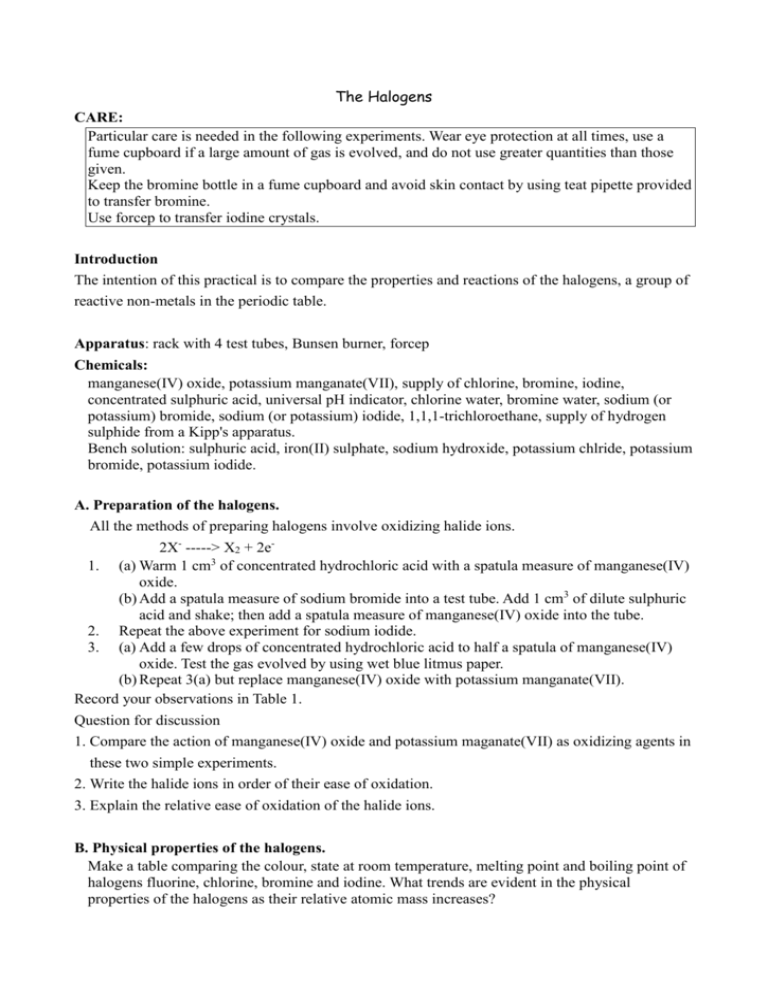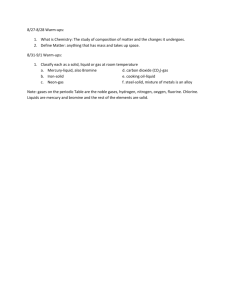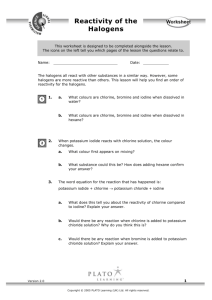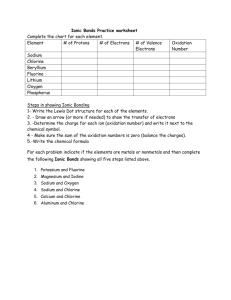Halogens-2
advertisement

The Halogens CARE: Particular care is needed in the following experiments. Wear eye protection at all times, use a fume cupboard if a large amount of gas is evolved, and do not use greater quantities than those given. Keep the bromine bottle in a fume cupboard and avoid skin contact by using teat pipette provided to transfer bromine. Use forcep to transfer iodine crystals. Introduction The intention of this practical is to compare the properties and reactions of the halogens, a group of reactive non-metals in the periodic table. Apparatus: rack with 4 test tubes, Bunsen burner, forcep Chemicals: manganese(IV) oxide, potassium manganate(VII), supply of chlorine, bromine, iodine, concentrated sulphuric acid, universal pH indicator, chlorine water, bromine water, sodium (or potassium) bromide, sodium (or potassium) iodide, 1,1,1-trichloroethane, supply of hydrogen sulphide from a Kipp's apparatus. Bench solution: sulphuric acid, iron(II) sulphate, sodium hydroxide, potassium chlride, potassium bromide, potassium iodide. A. Preparation of the halogens. All the methods of preparing halogens involve oxidizing halide ions. 2X- -----> X2 + 2e1. (a) Warm 1 cm3 of concentrated hydrochloric acid with a spatula measure of manganese(IV) oxide. (b) Add a spatula measure of sodium bromide into a test tube. Add 1 cm3 of dilute sulphuric acid and shake; then add a spatula measure of manganese(IV) oxide into the tube. 2. Repeat the above experiment for sodium iodide. 3. (a) Add a few drops of concentrated hydrochloric acid to half a spatula of manganese(IV) oxide. Test the gas evolved by using wet blue litmus paper. (b) Repeat 3(a) but replace manganese(IV) oxide with potassium manganate(VII). Record your observations in Table 1. Question for discussion 1. Compare the action of manganese(IV) oxide and potassium maganate(VII) as oxidizing agents in these two simple experiments. 2. Write the halide ions in order of their ease of oxidation. 3. Explain the relative ease of oxidation of the halide ions. B. Physical properties of the halogens. Make a table comparing the colour, state at room temperature, melting point and boiling point of halogens fluorine, chlorine, bromine and iodine. What trends are evident in the physical properties of the halogens as their relative atomic mass increases? Record your observations in a tabular form (Table 2). C. Chemical properties of the halogens. Experiment 1 (a) Reactions of halogens with water. Working in a fume cupboard, pass through 5 cm3 of water for a few seconds. Test the pH of the resulting solution with universal pH indicator. (If there is no supply of chlorine, chlorine water is used.) (b) Shake one drop of bromine with 5 cm3 of water in a test tube until the bromine dissolves. Test the resulting solution with universal pH indicator. (c) Repeat the experiment using a small crystal of iodine in place of bromine. Record your observations in a tabular form (Table 3). Question for discussion 1. Chlorine water contains dissolved chlorine, together with a mixture of two acids which are formed when chlorine reacts with water. What are these two acids called? Write an equation for the reaction of chlorine water. 2. Compare the ease with which the three halogens dissolve in water, the pH of their resulting solutions and their action as bleaching agents. 3. What specific use does chlorine have as a bleach? Experiment 2 Solubility of the halogens in 1,1,1-trichloroethane (the solvent may be replaced by volasil) (a) Shake 3 cm3 of chlorine water with 1 cm3 of 1,1,1-trichloroethane in a test tube. (b) Repeat the experiment using 3 cm3 of bromine water (c) Repeat the experiment using a small crystal of iodine in place of chlorine water. Record your results in a tabular form (Table 4). For discussion Explain your observations in the three simple experiments. Experiment 3 Halogens as oxidizing agents (a) Reaction with hydrogen sulphide [Do these experiments in a fume cupboard.] Pass hydrogen sulphide from a Kipp's apparatus through 3 cm3 of chlorine water. Compare the final solution with clear chlorine water. (b) Repeat the experiment using bromine water in place of chlorine water. . (c) Reaction with iron(II) sulphate solution Put 3 cm3 of iron(II) sulphate solution into each of two test tubes. To one test tube add 3 cm3 of chlorine water and to the other 3 cm3 of water. The second test acts as a 'control'. (d) Investigate whether Fe2+ ions have been oxidized to Fe3+ by adding 1 cm3 of sodium hydroxide solution to each tube. (e) Repeat experiment (c) using bromine water in place of chlorine water. (f) Repeat experiment (d) using sodium bromide in place of sodium chloride. Questions for discussion 1. What is a 'control'? 2. What evidence does the addition of sodium hydroxide provide for the oxidation of Fe2+ ions by chlorine? 3. Comment your results for experiment 3. Experiment 4 Relative reactivity of the halogens as oxidizing agents Investigate the action of chlorine water on 3 cm3 of the following solutions. Shake the resulting solution 1 cm3 of 1,1,1-trichloroethane (or volasil). a. KBr(aq) b. KI(aq) and then the action of bromine water on c. KBr(aq) d. KI(aq) Tabulate the results of the four tests showing the solutions mixed, the changes which occur before 1,1,1-trichloroethane is added, the final colour of the 1,1,1-trichloroethane layer and the equations for the reactions where appropriate (Table 5). For discussion: What is the order of the halogens as oxidizing agents? Results Table 1 Reaction with Observation 1. Reaction with NaBr 2. Reaction with NaI 3. (a) HCl + MnO2 (b) HCl + KMnO4 Equation Table 4 Observations Experiment 2 (a) (b) (c) Experiment 3 (a) (b) (c) (d) (e) (f) Students are required to work out Table 2, 3 and 5. END Equations


![[1] - Boswellsgmt](http://s3.studylib.net/store/data/006603407_1-fadfbce8d94050a9fb3c38a07d86e8ee-300x300.png)



